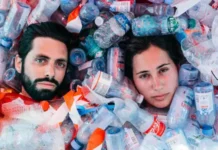
Freeing nature from plastic is a challenge that must be taken up collectively if we want to save our health and that of the Planet. Due to the continuous release of plastic into nature, for example, microplastics have invaded soil, water and air, even making their way up the food chain to us. Every day, more than 100,000 microplastics, amounting to several milligrams, enter our bodies, exposing us to a veritable cocktail of harmful chemicals, and the damage to the health of organisms is therefore not to be trifled with. This is just one of the many results of the continuous introduction of plastic into nature that we have been dragging along since the 1960s. Today, the Mediterranean Sea is a plastic hotspot: every year, some 229,000 tonnes of plastics end up in its waters. As if 500 containers were dumped in the water every day. The sea around us also has another sad record, namely, it has the highest concentration of microplastics ever measured in the seabed: 1.9 million fragments per square metre.
Carnival runs the risk of turning into a “plastic party”, but it is possible to respect the fun and crazy tradition without leaving too much polluting waste behind: among the tricks suggested by the WWF in its Ecotips is to replace confetti and plastic streamers with do-it-yourself products, by shredding old magazines, papers or gift cards, or to recycle old clothes to create your own original costume without buying new ones, and to use natural and organic make-up to colour your skin and face, avoiding glitter. These are microplastics that once washed off your face end up in the sea. Finally, to eat typical carnival sweets and not only, use recyclable and compostable crockery or, even better, your own to be washed at home: the party will be even more beautiful if it leaves behind more joy and less waste.
The ecological Carnival should become a ‘must’ for communities that historically have planned celebrations and events: some municipalities (too few given the emergency) have decided to reduce the use of plastic with specific ordinances, such as that of Viareggio, which for the fifth consecutive year instructs shopkeepers to offer disposable containers made of biodegradable and compostable material for the distribution of drinks and food. Similar initiatives also took place in Ferrara, Capo d’Orlando and Tropea. Even in the ‘symbolic’ city of Carnival, Venice, similar initiatives are being adopted: a recent ordinance of the Municipality has banned the use of plastic confetti and streamers also for this edition, asking citizens and tourists to use only biodegradable materials. In a city like Venice, which is located by the sea, it is very easy for confetti, streamers and glitter from the streets to end up in the sea, polluting the environment and the fauna living there.
The initiative is part of the joint path that the city has undertaken with WWF and other partners as part of the global Plastic Smart Cities initiative created to support cities in combating plastic dispersion in nature . The project, with the help of the WWF, has led to the definition of an action plan developed by the City of Venice with the investee companies Gruppo Veritas (the main multi-utility in the Veneto region) and Gruppo AVM (transport services, mobility, territorial marketing and cultural and tourist promotion of the city) to implement and promote activities that prevent, minimise and manage plastic, both as a resource and as waste.






































